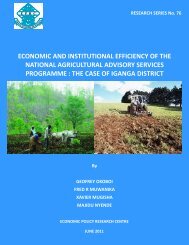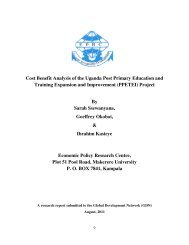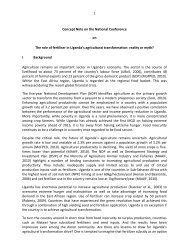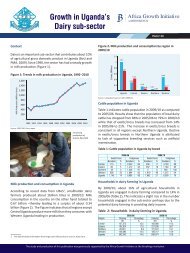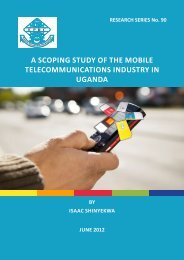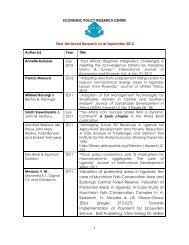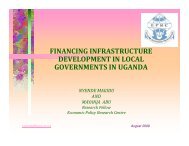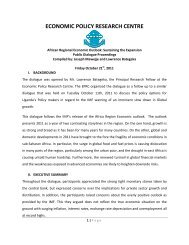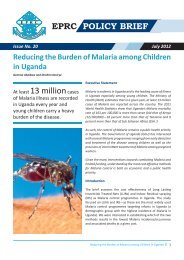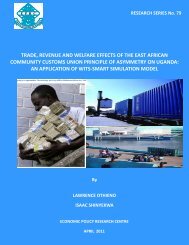The Political Context of Financing Infrastructure Development in ...
The Political Context of Financing Infrastructure Development in ...
The Political Context of Financing Infrastructure Development in ...
You also want an ePaper? Increase the reach of your titles
YUMPU automatically turns print PDFs into web optimized ePapers that Google loves.
<strong>The</strong> <strong>Political</strong> <strong>Context</strong> <strong>of</strong> <strong>F<strong>in</strong>anc<strong>in</strong>g</strong> <strong>Infrastructure</strong> <strong>Development</strong> <strong>in</strong> Local Government<br />
would also <strong>in</strong>crease fiscal discretion <strong>of</strong> local governments. Although this could give local<br />
councils leverage on both <strong>in</strong>frastructure development and oversight functions, it is difficult<br />
to discern that the central government m<strong>in</strong>istries are readily will<strong>in</strong>g to loose or let go <strong>of</strong> tight<br />
grip over their sectors.<br />
Section 83(4) <strong>of</strong> the Local Governments Act CAP 243 provides for equalisation grants. It<br />
stipulates that an equalisation grant is the money to be paid to local governments for giv<strong>in</strong>g<br />
subsidies or mak<strong>in</strong>g special provisions for the least developed districts and shall be based on<br />
the degree to which a local government unit is lagg<strong>in</strong>g beh<strong>in</strong>d the national average standard<br />
for a particular service. While many local governments lag beh<strong>in</strong>d national standards <strong>in</strong><br />
service delivery, equalisation grants cont<strong>in</strong>ue to be the least and <strong>in</strong> many cases the entitled<br />
local governments do not receive it. <strong>The</strong> LGFC (2009) notes that the grants transferred to<br />
local governments as a share <strong>of</strong> the total national budget (exclusive <strong>of</strong> amortization and<br />
<strong>in</strong>terest payments) has decl<strong>in</strong>ed from 25.5 percent <strong>in</strong> FY 2003/4 to 20 percent <strong>in</strong> the FY<br />
2009/10. <strong>The</strong> LGFC further notes that there is a big imbalance <strong>in</strong> the levels and growth rates<br />
among the grants. In the budget for FY 2009/10, conditional grants constituted 85.5 percent,<br />
unconditional (<strong>in</strong>clud<strong>in</strong>g compensation for Graduated Tax) grants comprised 14.2 percent<br />
while equalisation grants comprised 0.3 percent. <strong>The</strong> high level <strong>of</strong> conditional grants means<br />
that priority sett<strong>in</strong>g is largely done at the centre and certa<strong>in</strong> key priority expenditure needs<br />
<strong>of</strong> local government are not funded. <strong>The</strong> overwhelm<strong>in</strong>g conditional grants means that the<br />
central government has an overarch<strong>in</strong>g over sight function on <strong>in</strong>frastructure development <strong>in</strong><br />
local councils. <strong>The</strong>refore, despite the fact that local governance is legally decentralized, much<br />
<strong>of</strong> the control is still exercised by the central government.<br />
<strong>The</strong> Fiscal Decentralization Strategy (FDS) which was launched <strong>in</strong> 2002 by MoFPED and<br />
envisaged assignment <strong>of</strong> local governments more f<strong>in</strong>ancial autonomy has not yet been<br />
implemented. Steffensen (2006: 118-119) highlights the FDS scheme which among others<br />
<strong>in</strong>cluded the creation <strong>of</strong> flexibility <strong>in</strong> the use <strong>of</strong> grants. <strong>The</strong> FDS also referred to as Recurrent<br />
Transfer Scheme is supposed to reduce the number <strong>of</strong> grants, to enhance allocative efficiency<br />
and local government autonomy. <strong>The</strong> grants were to be grouped <strong>in</strong> six or seven sectors to<br />
establish among others, common modalities and report<strong>in</strong>g systems. <strong>The</strong> FDS further envisaged<br />
that with<strong>in</strong> each grant, budget l<strong>in</strong>es would determ<strong>in</strong>e the spend<strong>in</strong>g on various items especially<br />
development (if relevant), recurrent non-wage parts, recurrent wage parts, and projects (such<br />
as National Agriculture Advisory Service), but the number <strong>of</strong> these earmarked areas would be<br />
kept to the bare m<strong>in</strong>imum to ensure sufficient flexibility. However, as noted earlier, the MoLG<br />
(2006b) <strong>in</strong>dicates that 95 percent <strong>of</strong> transfers from central government to local governments<br />
are <strong>in</strong> form <strong>of</strong> sector conditional grants. In this regard, the local government f<strong>in</strong>ancial flexibility<br />
and autonomy as envisaged <strong>in</strong> the FDS rema<strong>in</strong>s unimplemented s<strong>in</strong>ce guidel<strong>in</strong>es and budget<br />
l<strong>in</strong>es for conditional grants are determ<strong>in</strong>ed by the central government. Moreover, the priority<br />
18<br />
Economic Policy Research Centre - EPRC




